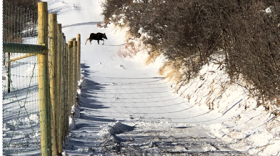The Interstate-80 Wildlife Bridge opened last month traversing the north and south sides of the freeway near the top of Parley’s Canyon. The organization pushing the project and convincing UDOT to fund a safe migratory option for animals is called Save People-Save Wildlife. Their work isn’t done. Carolyn Murray has this report:
The wildlife bridge is meant to save people and the animals that migrate this section of the Wasatch Mountains near Parley’s Summit on I-80. Sharon Cantwell is one of the founders of the Save People, Save Wildlife group. She talks about her experience on that very cold day in December when the ribbon cutting ceremony occurred.
"It really was the best day of my life. Standing on that bridge, which you covered, when we had the opening which was the soft opening and hard close of the bridge to humans. We stood there with UDOT. We walked across the bridge and back. And, I was overwhelmed by the size of it. We actually thought it was on the small side of what we would have preferred. But, once you get on the bridge and you walk across it, you realize, it’s a much bigger situation than we ever could have dreamed of.”
UDOT and the Division of Wildlife Resources did not expect the migration across the bridge to begin so quickly after it was installed. Save People Save Wildlife Co-founder Erin Ferguson said multiple cameras will be installed and people and pets must stay off in order for the bridge to be successful. She said the animals will learn to use it to cross.
“Monitor not only wildlife use but if humans tried to use it, DWR and UDOT will be alerted as so, and pending fines will result. We just ask that people be respectful, that it’s awildlife bridge exclusive, and give them the option to get that as part of their seasonal migration routine, right? Give them the opportunity to learn to use it. And so, to your point earlier, the wildlife fencing that was put in place will guide the animals to that bridge. They’ll walk the fencing until they get to the wildlife bridge and are able to cross.”
Cantwell said a public education campaign is coming with videos, details and ways for interested people to follow the progress of animals using the bridge. Cameras will identify wildlife usage, but also identify people on the bridge and she said there will be fines imposed. There are locked gates and signage on both sides of the freeway.
They’ve documented wildlife deaths due to collisions in the past three years. The first fencing project started in 2016 and the reduction in collisions dropped by half in the area that is now fenced.
“We’re already seeing a decrease of more than 50 percent in wildlife vehicle collisions just in having that stretch of wildlife fencing in place from Summit to Jeremy Ranch. I mean it’s reduced by half. That’s amazing.”
Their next effort to install fencing and cattle guards is for the Jeremy Ranch to Kimball Junction stretch of I-80. There’s no official tracking of the number of collisions between Jeremy and Kimball Junction but Cantwell said Save People Save Wildlife is keeping a spreadsheet by milepost marker.
“One incident that really was very upsetting to all of us was the mountain lion that was killed right at the exit for Kimball going east.”
They’ve raised over $13 thousand-dollars but according to UDOT, the fencing on both sides of the highway and installing eight cattle guards will cost a million dollars. Cantwell said the animals wander onto the freeway from the on and off ramps.
Comments on social media have made fun of the idea that animals can learn to funnel along a fence line and use a bridge, but statistics show it will happen. One area neighbor has posted repeatedly that she can see animals using the bridge regularly from her home. A moose was present near the bridge during the grand opening last month. Once the cameras are installed, the public at large will be able to follow the action.
State Route 224, one of two corridors into Park City has frequent road kill, of moose, deer and elk. Ferguson thinks eventually, all the high collision areas can be addressed.
“Our interstate system has basically blocked off all the north south flow for animals across the country. With this project, in the past couple of years alone, hopefully we’re setting precedence for future freeway interstate repairs and infrastructure repair, they will incorporate a certain percentage or a component of wildlife mitigation when they do the freeway work.”
Visit the Save People save Wildlife.org website to learn more and to donate.






